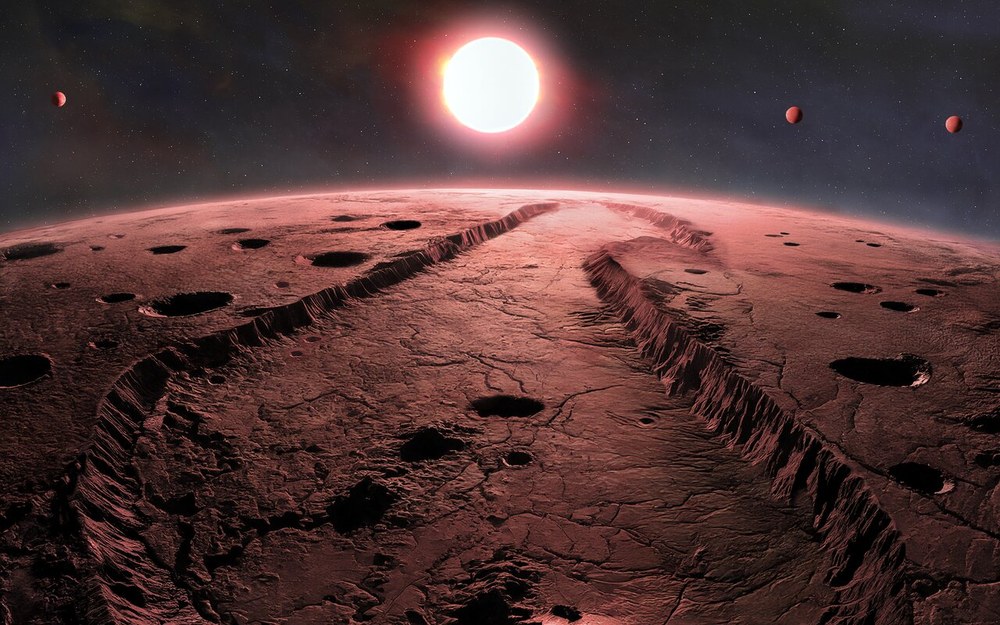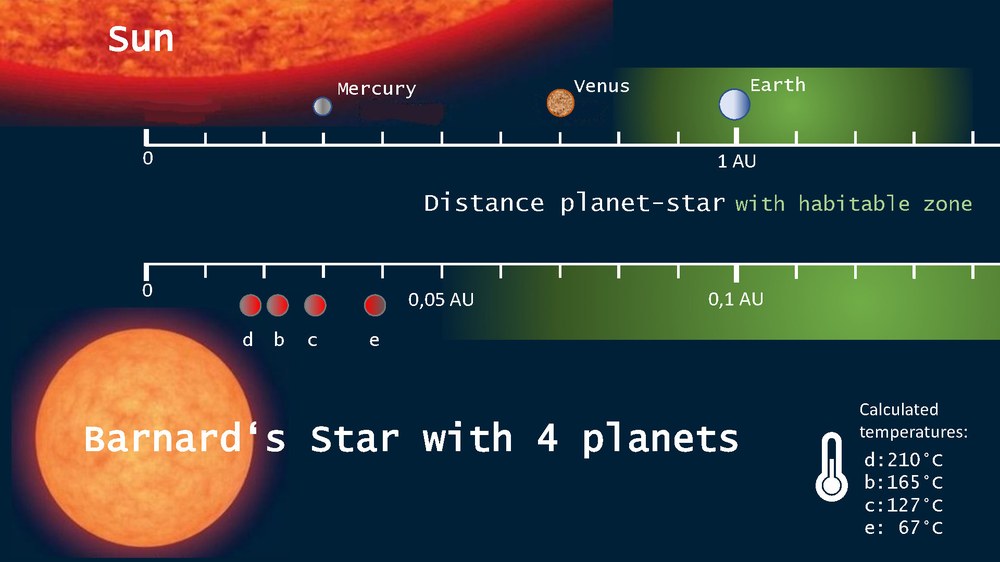Barnard's Star actually hosts four planets
Barnard's star is the second closest neighbour to our Sun and the closest single star with a planetary system. Only the star Proxima Centauri with two planets is closer to us, but it is part of a triple star system. At a distance of 6 light years, Barnard's Star is in our immediate neighbourhood. This proximity makes it so interesting for our search for exoplanets on which life could possibly exist.
In March 2025, an article was published in the scientific journal Astrophysical Journal Letters showing that Barnard's Star is actually orbited by four planets. Until then, the existence of one planet was certain, a kind of mini-Earth with an orbital period of just 3.15 days. In addition, three more planets were suspected, which have now been confirmed. These three are also mini-Earths with 1/4, 1/3 and 1/5 Earth masses and need 2.34 days, 4.12 days and 6.74 days respectively for one orbit. As Barnard's star is a dwarf star, which is significantly smaller and cooler than the sun, the life-friendly zone is also closer to the star. Planets in this habitable zone would have orbital periods of between 10 and 42 days. All discovered planets lie outside the habitable zone and have temperatures of at least 67°C in the most favourable case.
Where does the name Barnard's star come from?
Barnard's Star has a proper motion of 10.4 arc seconds per year. Stars whose position in the sky shifts remarkably quickly are called fast-moving stars. The astronomer and self-taught astronomer Edward Emerson Barnard (1857-1923) measured this large proper motion for the first time in 1916 and thus gave the star its name.
Possible planetary discoveries in the 20th century
The search for a planet around Barnard's Star began more than eighty years ago. In 1938, astronomers at the Sproul Observatory in the USA analysed the parallax in order to measure the movement of the star more precisely and search for possible companions. For a long time, the existence of a 1.7 Jupiter-mass companion around Bernard's star, which Peter van de Kamp (1901-1995) believed he had discovered, was accepted by many astronomers. Van de Kamp interpreted orbital disturbances as a result of the gravitational interaction between a massive planet and the low-mass star. From 1969 onwards, he even surmised two Jupiter-sized planets with orbital periods of 12 and 26 years at distances of 2.8 and 4.7 AU respectively.
However, the existence of these planets could never be independently proven by another research group, but the assumption remained until the 1980s. Presumably, errors in the measuring instrument led to the misinterpretation, which van der Kamp refused to admit until his death.
Planet discovery in our time
In 2018, an analysis led by the Georg-August University in Göttingen was published, which recorded radial velocity data for over 20 years. A super-Earth with a mass of at least 3.2 Earth masses, an orbital period of 233 days and a distance of 0.4 AU was suspected. Three years later, however, it turned out that the signal was caused by stellar activity.
In 2024, a study was published by the VLT of the European Southern Observatory ESO with the result that Barnard's Star has at least one planet that is about half the mass of Venus and takes 3.15 days to orbit. There were also indications of three other candidates with orbital periods of less than ten days. This assumption has now been confirmed by independent measurements with a new instrument at the Gemini North Telescope in Hawaii.
Have a closer look:
Press release by the Gemini Observatory, March 11, 2025: Planetary System Found Around Nearest Single Star | Gemini Observatory
Basant et al, AJ, 2025: “Four Sub-Earth Planets Orbiting Barnard's Star from MAROON-X and ESPRESSO” https://iopscience.iop.org/article/10.3847/2041-8213/adb8d5
González Hernández et al. A&A 2024: “A sub-Earth-planet orbiting Barnard’s star” https://www.aanda.org/articles/aa/full_html/2024/10/aa51311-24/aa51311-24.html


